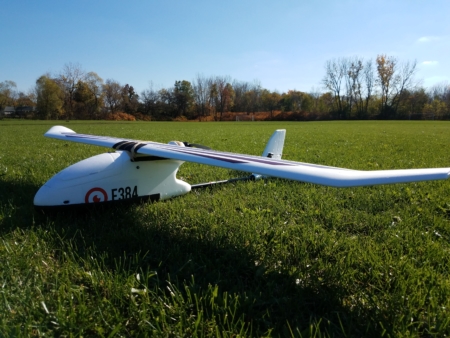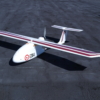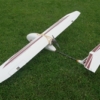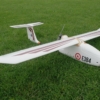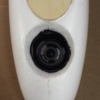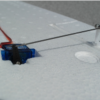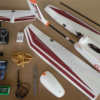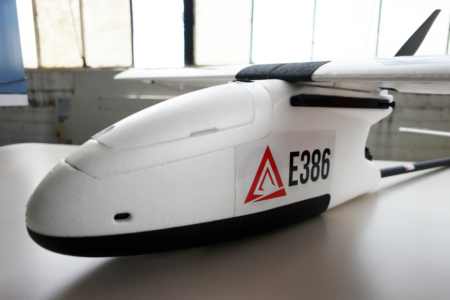Description
The E384 fixed wing UAS is one of the leading drones in the world for Construction, Environmental Conservation, Mining, Precision Agriculture and Surveying.
Have Questions? Contact us anytime! Our helpful support team will be happy to explain all the options as they relate to your project.
Specifications:
- Dimensions: 190cm Wingspan, 130cm Length (75 x 51 inches)
- Wings and body disassemble for easy transport
- Weight: 2.5kg (5.6 lbs)
- Endurance: 90 minutes flight time
- Cruise Speed: 13m/s (29 mph)
- Range: 70km (44 miles)
- Map up to 960 geo-referenced acres per flight at 3.0cm/pixel resolution (390 Ha)
- Payload: 1kg (2.2 lbs)
- Automatic lens protection for landing
- Complete mission planning and operations software
- For your Windows 7 or 8 laptop (not included)
- Autonomous flight, Return-to-launch, Automated pre-flight checklists, much more
- Complete operating instructions online and downloadable
- Operating Conditions
- MSL Ceiling: 3,960 meters, (13,000 ft), – auto take-off tested to 3,100 meters, (10,000 ft)
- Max wind speed: 8 m/sec, (18 mph) for autonomous operation
- Telemetry Range: 5 km+ with standard RFD900+ radios, (3.1 mi)
Camera Options:
There are two standard RGB camera options for the E384: The the Sony R10C and RX1R II. All cameras include an automatic hatch mount and utilize Intellishoot, which automatically takes pictures at optimal overlap to maintain consistency and eliminate redundant data collection. The major differences in these cameras are as follows.
- Sony R10C – 20.1MP Resolution, Landscape Orientation for Maximum Efficiency, PPK Compatible, Full Power Provided by Aircraft
- Sony R10C Plus Companion Computer – Automatically geotags images in real time and uses camera feedback to improve geotag accuracy. Images are stored with geotags in EXIF data and can be imported directly into any photogrammetry software, bypassing the normal geotagging process.
- Sony RX1R II – 42MP Full Frame Exmor R BSI CMOS Sensor, PPK Compatible, Supplementary Power from Aircraft. Currently only compatible with E384-Heavy configuration.
Other camera options are available for specialty applications, please contact us for more information.
- Customized Canon Powershot S110 with infrared filters specifically designed to measure NDVI. Using ratios of visible light to infrared light, we can calculate NDVI, which allows for the detection of crop health.
- MicaSense RedEdge
- Parrot Sequoia
- FLIR Vue Pro
Long Range Configuration
The E384-LR Long Range configuration uses more dense Lithium-Ion battery packs to fly even longer. This adds about 200g of weight to the aircraft and increases flight time to 110 minutes. The E384-LR features terrain-follow capability to ensure a safe and consistent altitude needed when covering large areas. A special algorithm designed just for the E384-LR also optimizes flight speed in the face of strong headwinds when the aircraft would otherwise slow to a crawl. This increases the maximum sustained windspeed that the aircraft can safely fly in.
PPK Precision Geotagging Option
Event 38 offers two PPK GPS options integrated with the E384. The Emlid Reach PPK GPS is an L1-only receiver that enables data collection at centimeter level precision without ground control points. See our case study to read more about the system’s real world accuracy tests. A dual frequency L1/L2 PPK GPS receiver made by Event 38 and powered by Piksi Multi is also available. The accuracy of both systems is comparable. The main advantage of upgrading to L1/L2 is to improve time to first lock and Q1 solution reliability levels.
Both systems include:
- Integration of precision timing on the R10C or RX1R II camera
- GPS receiver with integration with an E384/6
- Antenna and ground plane installation on the E384/6
- Image utility to augment RTKLIB post-processing
PPK GPS systems require a receiver both on the aircraft as well as one in a fixed location on the ground to provide corrections. Both systems are compatible with all known survey-grade GPS receivers, as long as they are able to save raw observation files in Rinex format. In certain areas, you may be able to use publicly available base stations such as the CORS Network in the United States. We recommend the Reach RS+ base station for L1-only systems. We do not currently offer any L1L2 base station receivers.

